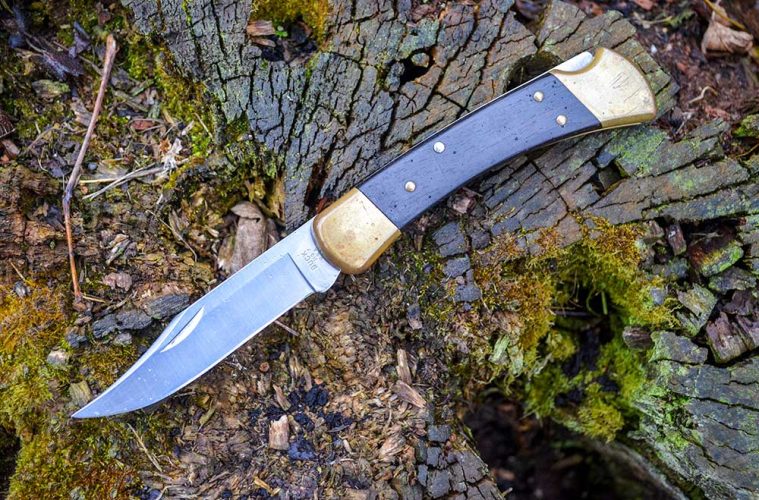THE ICONIC BUCK 110 FOLDING HUNTER
or many of us, that ubiquitous folder with the brass bolsters and woodgrain scales was our first real knife. Simple, understated, but a definite workhorse. It can do everything from cutting fruit for your lunch to field dressing a deer. Even non-knife people know what you mean when you call it a “Buck knife.”
The Buck 110 isn’t just one of the most common folding knives in the world. It is also one of the most copied. Any flea market or pawn shop is all but guaranteed to be swimming in clones, many of them stamped Pakistan and all of them of dubious quality. But even the most casual once over will tell you whether you’re holding a real
Buck knife in your hand.
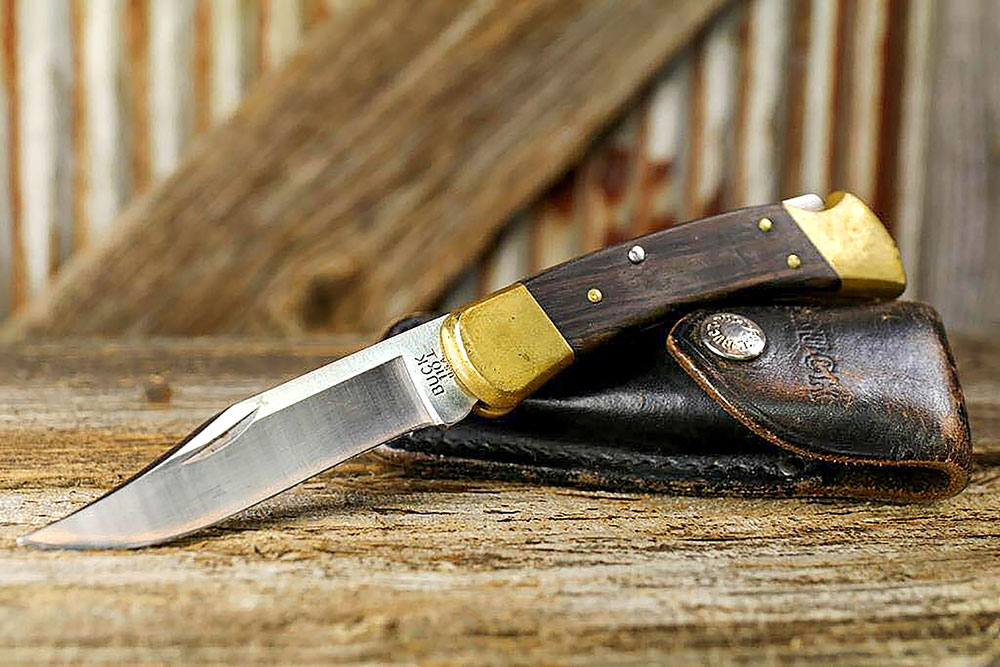
A good quality leather sheath accompanies every Buck 110. Buck Knives photo.
HISTORY OF THE 110
Buck Knives got underway back in 1902, when Hoyt Buck figured out a new way to temper steel to improve edge retention. He and his son Al eventually teamed up to start H.H. Buck and Son. Hoyt passed away in 1949, and Al kept the business afloat, eventually incorporating as Buck Knives, Inc. in 1961.
It was in 1964 that the Model 110 Folding Hunter debuted, and it rocked the knife world to the core. Here was a folding knife that was nearly as strong as a fixed blade, yet the lock release required just minimal pressure. It was large enough to handle just about any common task, but folded small enough to carry anywhere. A true legend was born.
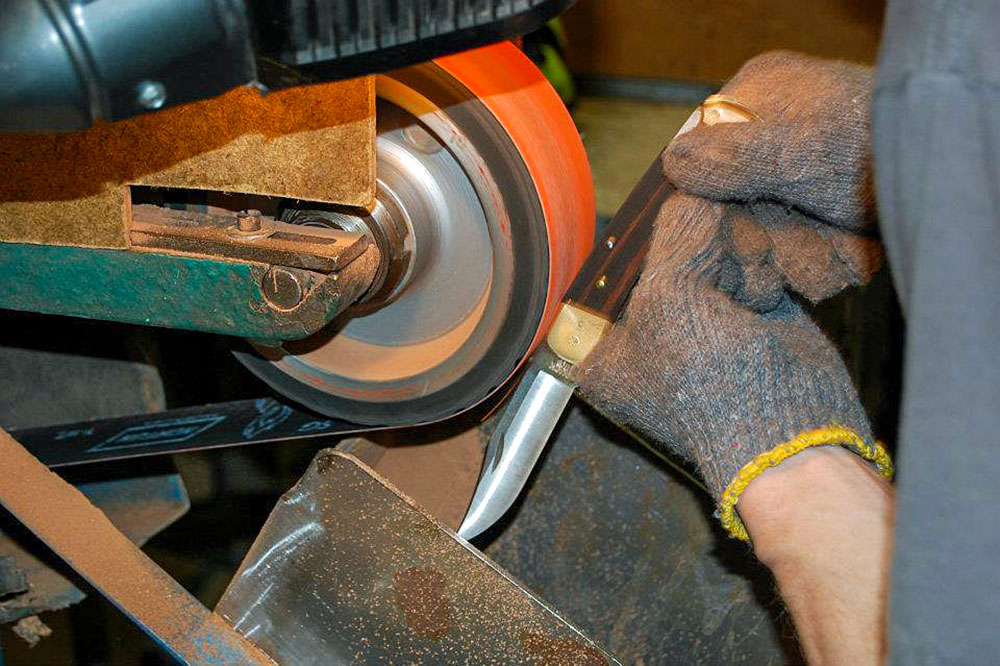
Even today, Buck is producing knives right here in the United States. Buck Knives photo.
DECEPTIVELY SIMPLE DESIGN
It was the locking mechanism that really solidified this knife’s reputation early on. The blade is allowed to swing open fairly easily, with little to no resistance. Once it is fully extended, it is locked in place by a rocker bar that snaps shut on the blade.
At that point, the knife is rock solid. While you should never treat a folder like you would a fixed blade, at least in terms of relying overmuch on that rocker bar, the Buck 110 is known the world over for its lockup strength.
Yet, for all that legendary stoutness, once just a bit of pressure is applied to the release, the blade can swing shut without hesitation. It truly is a remarkable design, and one that’s been emulated and duplicated ad nauseum ever since.
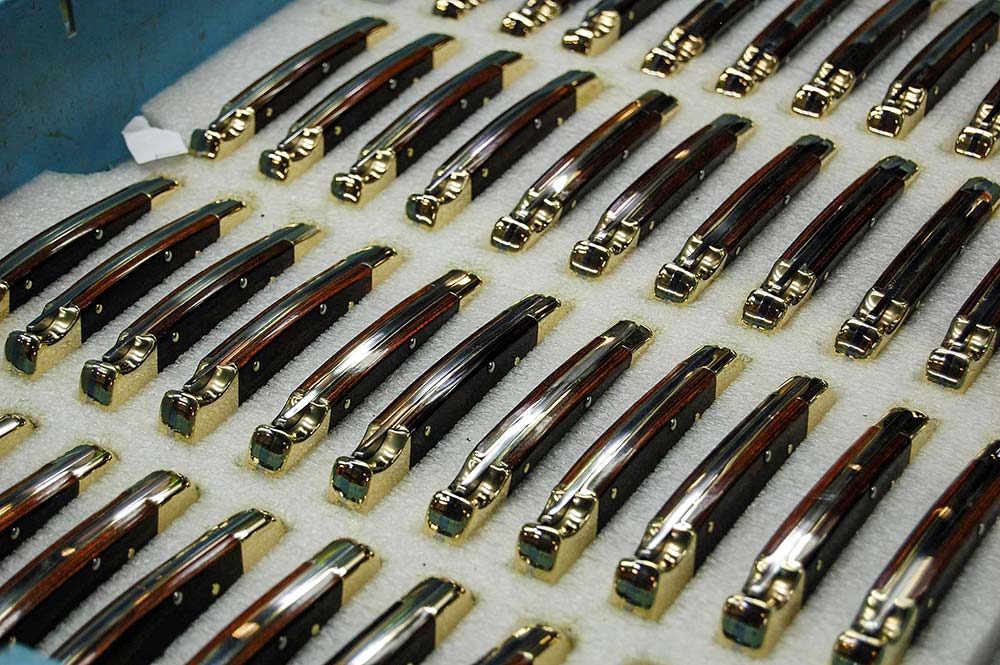
Shined up, polished, and ready to head out the door. Buck Knives photo.
The blade itself is a clip point, with a needle-sharp tip and plenty of belly for slicing. Many think of the almost stereotypical Bowie knife but in miniature. At about 8.5 inches long when open, it isn’t a small knife by any stretch. The 3.75-inch blade is 420HC stainless steel. Buck has perfected its heat treat process to such a degree, no pun intended, that while many knife aficionados would otherwise thumb their nose at 420HC, it gets a pass here.
There’s a familiar solidity to the Buck 110. At 7.2 ounces, this isn’t a lightweight option for an EDC blade, but that’s OK. If you’re carrying this knife, you’re probably not concerned about counting ounces in your overall loadout. This is very much a working knife, much more at home out in the field getting dirty than sitting on a desk in a high-rise office.

One of the earliest advertisements for Buck Knives, charging a whopping $5.00 including shipping. Buck Knives photo.
When the knife was originally introduced, Buck used genuine ebony for the handle material. However, in the 1990s, federal regulations focusing on endangered woods caused Buck to explore other options, settling on using a resin-treated wood.
They have since partnered with Taylor Guitars, a company that not only produces some of the world’s greatest acoustic guitars, but also has an incredible conservation project that allowed Buck to return to using ebony.
Brass bolsters provide the perfect accent to the wood and complete the iconic appearance of the Buck 110. Each knife is sold with a genuine leather belt pouch, as most tend to feel the knife is a bit large for pocket carry.
While there have been a number of variations produced over the years, usually centered around different materials used for the handle, there’s just something about the classic 110.
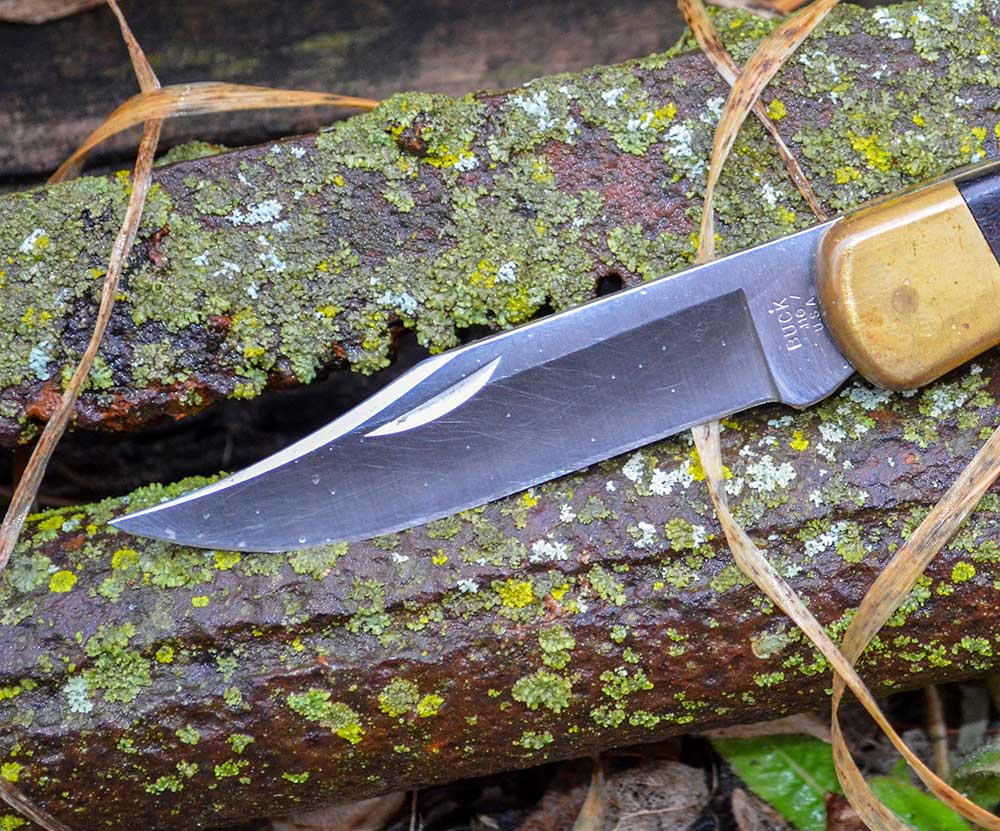
The clip point blade is handy for any number of chores. The sharp point is great for boring new holes in a leather belt, for example. Author photo.
STORY TIME
Given how long the knife has been around, in large part essentially unchanged, I figured some great stories would be out there. So, I asked around on social media, requesting people to reach out to me with their memories about this classic knife. Here are just a few of the responses I received. Each of these has been edited slightly for length as well as for typos and such.
Benny J said, “My great uncle, who was a paraplegic, bought me a 110 when I was about 10. He gave it to me and said he didn’t know much about knives but knew I needed one of those. I’ve carried it for a lot of years growing up and now it’s in year 16 of (hopefully) 20, being carried in a pouch on my law enforcement belt.
“I’ve used it several times at work, from cutting seat belts to sandwiches. I most recently used it to cut a shirt off someone who had just shot himself. I have nicer Buck knives in my collection now, but this one means the most. My uncle is long passed, but I still think about him. After I retire, who knows what adventure we will tackle next.”
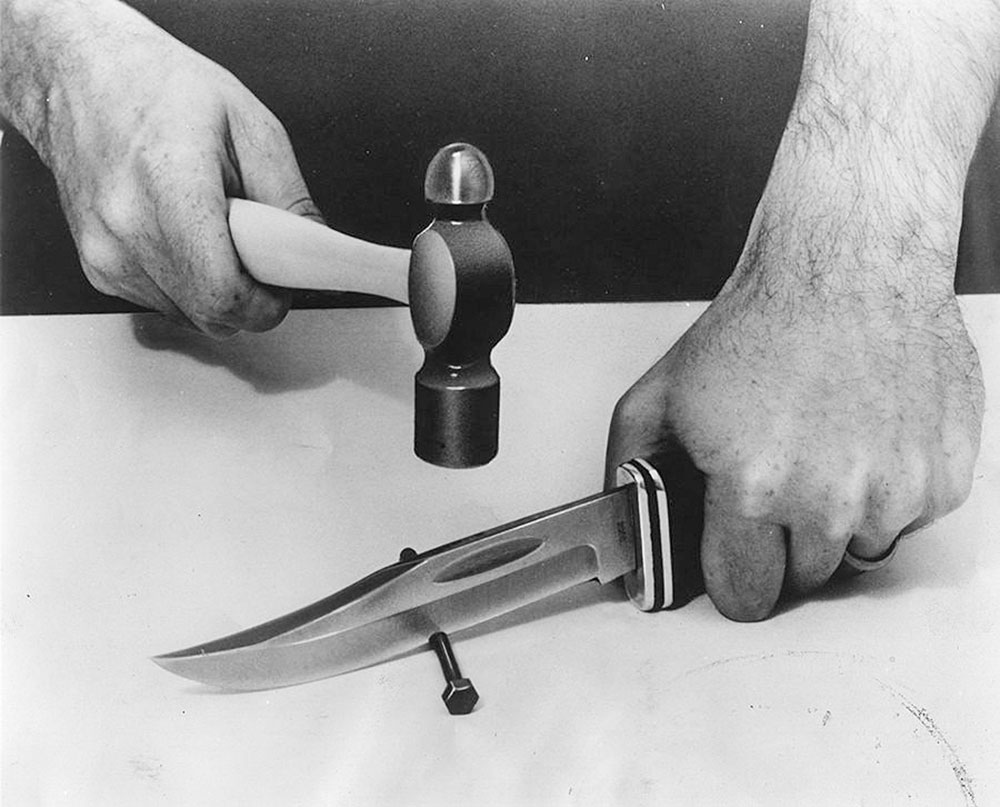
Early on, one of the most impactful demonstrations was to pound the knife edge through a steel bolt. They used this sort of image in many of their ads. Buck Knives photo.
Here’s another memory, this one from Bill H. “I was 16 years old, and my dad was taking me deer hunting in Meeker, Colorado, for the first time with his hunting buddies. But I couldn’t do so without a good knife, so my pops gave me a Buck 110, just like his! For me, this was a move into manhood. A real Buck knife was a dream come true. I treasured that knife for many years, including using it on my first buck.
“Several years later, I was traveling in Australia, and outside of Perth I dropped my most valued Buck knife on the street while it was open, and the blade snapped in half. I was devastated. Yet, when I went into a knife dealer there in Perth, the owner told me about the lifetime warranty, and replaced it on the spot! While I was so thankful for that replacement, these many years later, I wish I would have held onto the original one my pops had given me.
Even with a broken blade, it was still filled with many precious memories. I gave each of my three daughters a Buck just this last Christmas. To me, Buck isn’t just a knife company. The beauty and quality they have make them wonderful gifts to show family some love.”
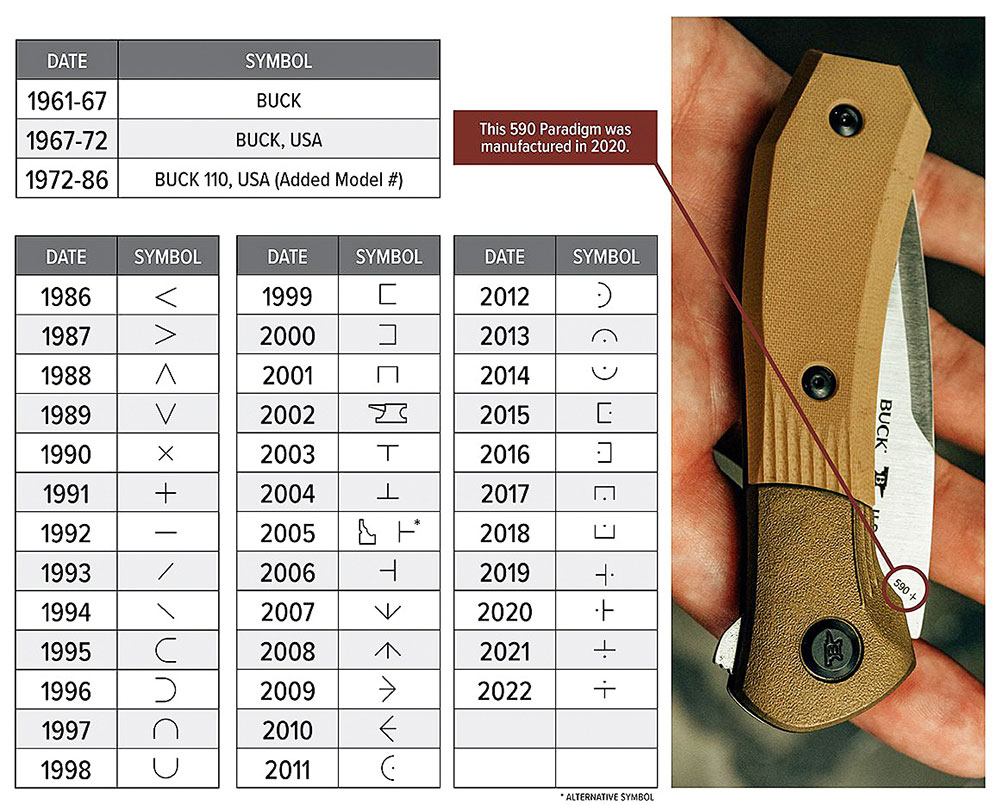
Beginning in 1986, each Buck 110 has a symbol stamped on the blade to denote the year of manufacture. Buck Knives photo.
Here’s what Ryan B. had to say. “When I became a dad, I knew my son would be brought up with the same traditions as I was. When he took a liking to the outdoors and hunting, I knew I had started another sportsman. After my son harvested his first deer (a doe), I wanted something special for him. I thought about my first good hunting knife and decided it had to be a Buck.
Also, I was at a new sporting goods store opening, and they had brand new Buck 110s on sale. I bought a couple, and I knew exactly what the plan for one of them was going to be.
“When my son Lane was not around, I honed it to a razor edge and put it in the back of my safe. My plan was when he harvested his first buck deer, he would get a new Buck knife. It took a couple years and on a very cold November morning, he got a spike buck.
We process our harvested game in my big shop. I told him to get it ready to be hung up, that I forgot my good skinning knife. I went in and got the black and yellow box out of the safe and headed back to the shop. He turned around, and I handed him the box. He looked at me funny and said ‘What’s this?’ I said a Buck for a buck! That knife was signed by CJ Buck in 2020, and the story related to him.”
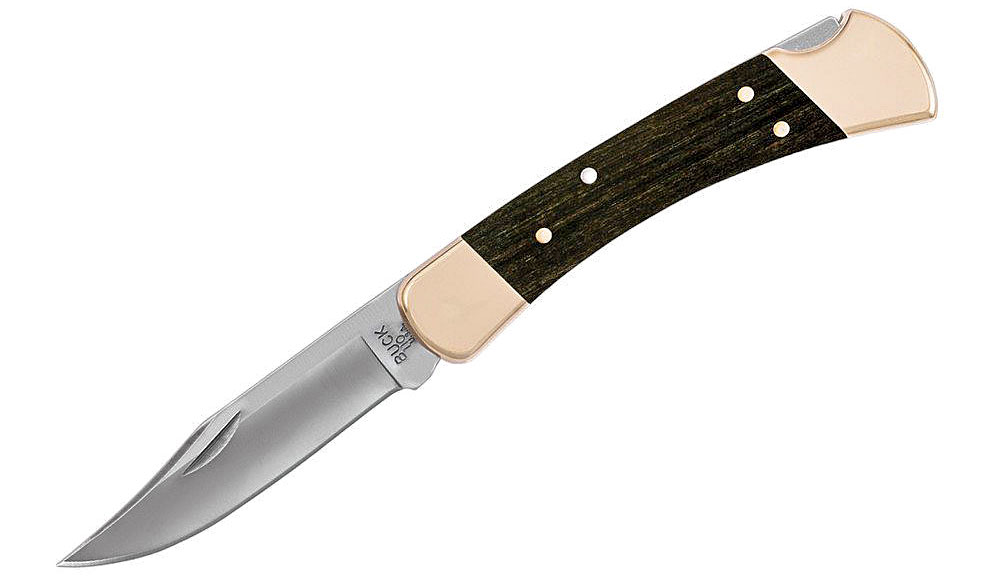

This newer model of the 110 has more rounded bolsters than an original model. Buck photo.
STILL A WINNER
Mike Stewart, founder of Bark River Knives, said, “There is no doubt that Buck has been the cornerstone of the modern knife industry since its inception. I feel that the Buck 110 was the first and most inspirational development in the folding knife market since it was introduced.”
He’s absolutely correct. Very few knife companies have had the impact that Buck has had. Even fewer knives are as well-known and as prized as the Buck 110. And it’s still going strong today. KI

The Buck 110 Hunter Sport is the latest model in the knife’s storied history. Buck photo.
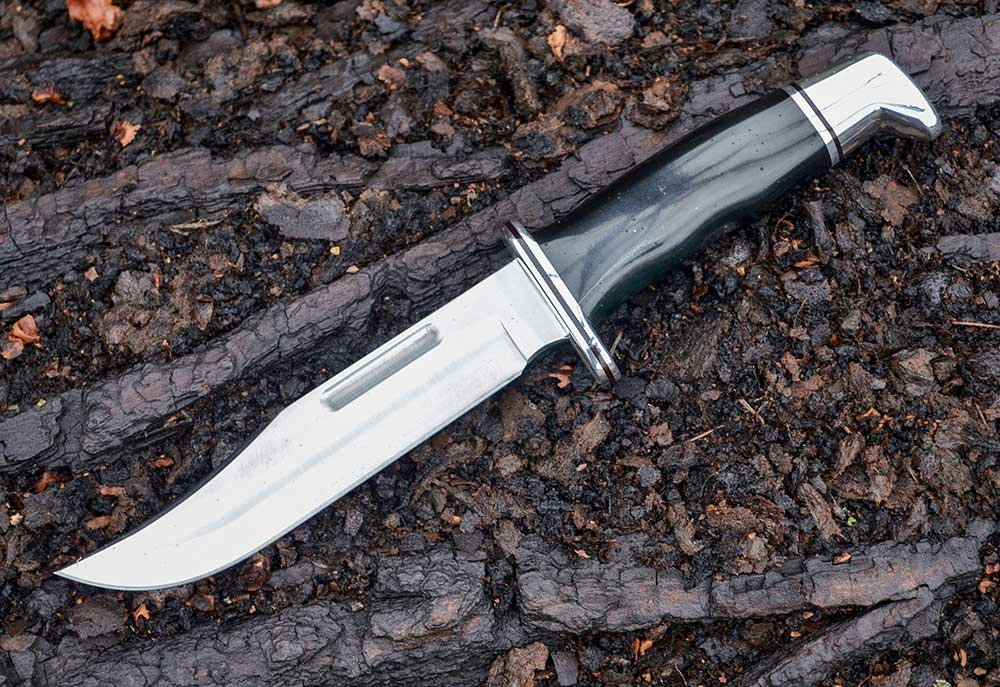
The Buck 119 is a classic field knife that has remained almost unchanged in design for decades.
BUCK 110 IN THE MEDIA
Being one of the most common folding knives in the world, it isn’t a surprise that it has been seen in countless movies and TV shows over the years. Here are just a few.
“The Dukes of Hazzard”
On numerous occasions, Bo and Luke Duke use their 110s to cut rope and such. Even if they’re not using the knives, the belt sheaths are visible in just about every episode.
“Longmire”
The titular character, Walt Longmire, carries his 110 everywhere he goes.
“Survival Quest”
This film stars Lance Henrikson as a survival instructor at an Outward Bound sort of school. Things go awry during a week-long class in the field. He and his students end up being tracked and then attacked by a competing school that has a much more militia sort of approach. Henrikson’s character uses a 110 to cut off the tagged ear of a poached deer killed by the other school.
“Harley Davidson & the Marlboro Man”
Don Johnson plays the Marlboro Man, and he uses a 110 to help him hotwire a motorcycle, as well as perform a few repairs on his cowboy boots that are more duct tape than leather.
THE 119 SPECIAL IS ANOTHER LEGENDARY BUCK KNIFE
While the 110 is the most well-known knife in the lineup, if we’re going to talk about Buck, we should also mention the 119. If you were to ask the average person to sketch out a fixed blade hunting knife, odds are that picture would look pretty close to the Buck 119 Special.
Hoyt Buck produced his first knife in 1902 using an old file that he fashioned into a workable blade. Over the next four decades, he dialed in the design, tweaking it here and there.
Then, after the attack on Pearl Harbor, the U.S. government requested donations of knives for troops heading to war. Hoyt began making knives in the basement of a church in 1942. The design was intended to be a do-it-all field knife, suitable for combat as well as dressing game and handling any other knife chores.
The clip point blade is 6 inches long, and the knife has an overall length of 10.5 inches. As with the 110, Buck uses 420HC steel for the 119.
The handle is phenolic resin, polished to a shine, and capped with an aluminum pommel. It is contoured for a comfortable fit in the hand. The knife is 80 years old, and the design is pretty much unchanged. There’s little sense in messing around with something that works so well.
SPECS
BUCK 110 IN THE MEDIA
Type: Single-blade folding knife
Blade Length: 3 ¾ inches
Blade thickness: 0.12 inch
Steel: 420HC stainless with Paul Bos heat treat
Configuration: Clip point
Closed Length: 4 7/8 inches
Handle: Crelicam ebony with brass bolsters
Locking Mechanism: Back lock
Other: Black leather belt sheath incl.
Origin: USA
MSRP: $59.99
SOURCE
Buck Knives
BuckKnives.com
A version of this article first appeared in the June/July 2022 print issue of Knives Illustrated.

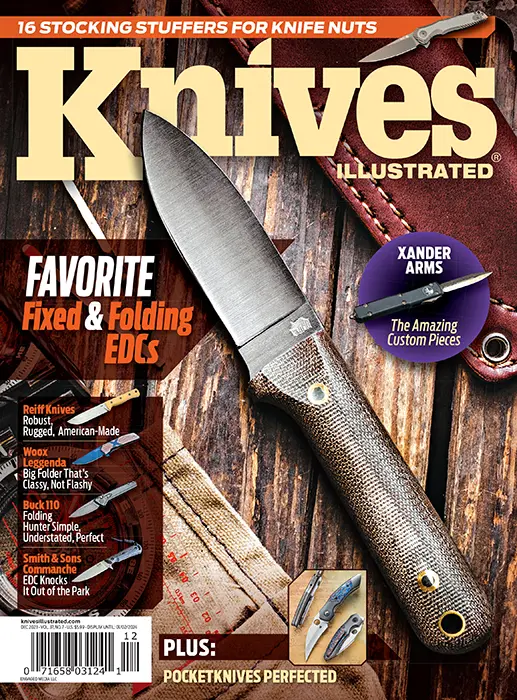 Subscribe / Back Issues
Subscribe / Back Issues